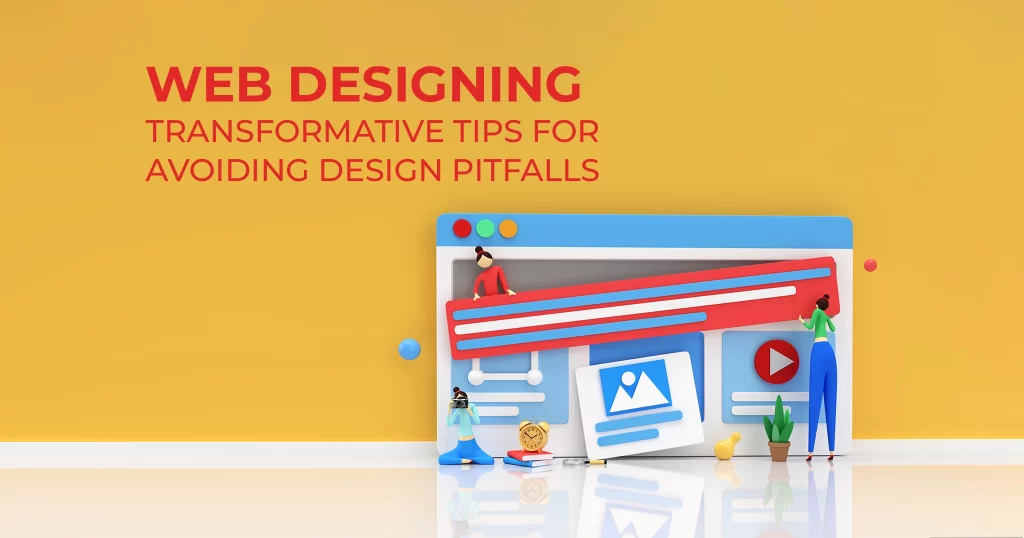Creating a user-friendly digital presence requires avoiding common mistakes. Website designers should stay ahead by sidestepping the common design pitfalls. These mistakes compromise website performance. You can hire a web design agency in Dubai to streamline the task.
Steering clear of these errors is important for web designers. It ensures that the user experience is seamless. Also, the website is optimized for maximum impact.
In this article, we are going to share with you some valuable website design tips & insights. These tips will ensure a user experience for your customers.
Common Design Pitfalls That You Should Avoid
Most website designers fall victim to common design mistakes. These design issues impact the performance of the website. Follow are the common issues you need to be mindful of during website design:
Slow Loading Speed
Slow-loading websites lead to high bounce rates. It creates a negative user experience. Factors such as large image files and unoptimized code cause slow loading speed. Excessive HTTP requests can also contribute to sluggish loading times.
Complex Navigation
Complicated navigation structures confuse your visitors. They make it challenging for them to find the information they need. The best web design agency in Dubai creates a straightforward and intuitive navigation system. It builds a positive user experience for your customers.
Non-Responsive Design
Non-responsive web design poses several issues. It fails to adapt to diverse devices & screen sizes. This results in distorted layouts and a negative user experience. Additionally, search engines favor mobile-friendly sites, impacting rankings. Creating a non-responsive design can result in decreased engagement.
Lack of Image Optimization
Uncompressed images can reduce the loading speed of your website. Image optimization is crucial. It helps maintain a balance between visual appeal and quick loading times.
Lack of Code Optimization
Poorly optimized code can result in longer loading times. It makes your website less efficient. Clean & well-structured code boosts website performance. It makes it easier to maintain and update the site.
Tips for Avoiding Website Design Pitfalls
Knowing about the website design mistakes is not enough. You also need to know how to tackle these mistakes. Here are some essential tips you can use to avoid these basic web design mistakes:
Set Clear Goals
Set clear goals for your website. Start by understanding the purpose of your website. Is it an e-commerce platform? Is It a portfolio website? or an informational blog?
Define your target audience. Think about the actions or activities you want them to perform on your site. It can be making a purchase of filling out an online form. Having a clear understanding of your goals will guide your website design in Dubai. It can contribute to a more cohesive and effective website.
Focus on User Experience
User experience (UX) matters in WordPress design and development. It impacts user engagement & interaction on your website. Start by creating an intuitive & user-friendly interface. Conduct usability testing with real users. This can identify potential pain points and areas for improvement. Pay attention to user feedback. Use that to adapt your design accordingly.
Analyze the user journey. Track it from the moment visitors land on your site to the completion of their intended action. Ensure that each step is clear for them. Responsive design adapts to different screen sizes. This approach provides a seamless experience across devices. Regularly update your site based on user behavior analytics & emerging design trends.
Use Consistent Navigation Experience
Consistency in navigation is key to a positive user experience. Maintain a clear and uniform navigation structure. This should be the same across all pages of your website. Users should be able to move from one page to another without confusion. Implement a logical hierarchy. Use a well-labeled menu & easy-to-understand links.
Use expectations and industry standards should be considered when designing your navigation. Familiarity with common navigation patterns helps users feel comfortable. They feel confident as they explore your site. Test your navigation on different devices. The purpose of testing is to ensure a consistent experience across various screen sizes.
Optimize Images & Code
Optimizing images and code is essential. It improves the website’s performance. Images with large file sizes can increase your site’s loading time. This leads to a poor user experience. Use image compression tools to reduce file sizes without compromising visual quality. Implement lazy loading for images to prioritize the loading of visible content first.
Minimize unnecessary cod. Use CSS and JavaScript minification tools. You can also leverage browser caching to reduce loading times. Audit and update your codebase to keep it streamlined.
Focus on Readability
Readability is a fundamental aspect of effective communication on the web. Choose fonts that are easy to read. Ensure appropriate font sizes and maintain sufficient contrast between text and background colors. Proper spacing and alignment contribute to a clean and readable layout.
Make sure to use headings and subheadings. Use bullet points to break up text. This makes the content more digestible. Test your website’s readability on various devices. Adjust typography settings as needed. Accessibility is also crucial as well. So, make sure your design is inclusive and complies with web accessibility standards.
Add a Clear CTA (Call to Action)
A well-designed Call to Action (CTA) is essential. It guides users towards desired actions on your website. Clearly define the primary actions you want users to take. Strategically place CTAs throughout your site. Make sure that they stand out visually.
Use action-oriented language in your CTAs. Consider A/B testing. Use it to test different CTA designs and placements to determine the most effective ones. Regularly analyze the performance of your CTAs through analytics data.
Use Mobile-First Approach
A mobile-first approach is important in design. It ensures that your website is optimized for accessing the internet on mobile devices. Start by creating a design that works well on smaller screens. And then progressively enhance it for larger devices.
Prioritize mobile-friendly features such as touch-friendly navigation. Use legible text and appropriately sized buttons. Test your design on different devices and use tools like Google’s Mobile-Friendly Test to ensure your website meets mobile usability standards.
Conclusion
Avoiding common pitfalls is vital for crafting robust websites. This approach ensures your website is appealing and functions seamlessly. Consider the tips we have talked about in this guide to build visually engaging & practical websites. Get in touch with us if you have any questions regarding the latest web design trends.



